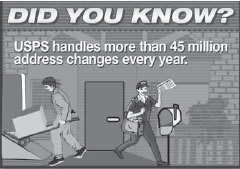Chapter 2 Our Customers
Products and Services
Postal Service products are offered through a domestic network of nearly 37,000 Post Offices, stations, branches, and contract postal units, and delivered to every address in the United States and worldwide through the networks of foreign postal administrations.
The Postal Act of 2006 separated postal products and services into two distinct categories — market dominant (referred to as mailing services) and competitive (referred to as shipping services). Different rules for each category allow the Postal Service to bring new products and services to market more quickly, with greater pricing flexibility.
Price changes for mailing services require at least 45 days notice and on average may not exceed the Consumer Price Index for the previous 12 months for a class of mail. Price changes for shipping services require at least 15 days notice for individual customer prices or 30 days notice for market-wide prices, and must produce sufficient revenue above a price floor that covers attributable costs and, for shipping services as a whole, an appropriate share of institutional costs.
MAILING SERVICES
Mailing services represent about 90 percent of all postal revenue. These services include First-Class Mail, Periodicals, Standard Mail, single-piece Parcel Post, Bound Printed Matter, Media Mail, Library Mail, single-piece International Mail, and Special Services such as Delivery Confirmation, Certified Mail, and Post Office box service.
First-Class Mail
First-Class Mail includes business and personal correspondence, bills, invoices, remittances, financial statements, and advertising. Any matter eligible for mailing weighing up to 13 ounces may be mailed as First-Class Mail. Matter containing personal information, partially or wholly handwritten or typewritten matter, or bills or statements of account must be mailed as First-Class Mail, unless mailed as Express Mail or Priority Mail, or otherwise exempted by the Postal Service. First-Class Mail is sealed against postal inspection and cannot be opened except as authorized. First-Class Mail that is undeliverable-as-addressed is entitled to be returned to the sender or forwarded without additional charge.
First-Class Mail revenue in 2007 was $37.564 billion, with a volume of 95.898 billion pieces. First-Class Mail revenue increased 1.4 percent and volume decreased 1.8 percent compared with 2006. The volume decline continued a downward trend starting in 2002. Between 2002 and 2007, total First-Class Mail volume declined 6 percent, with a decrease of 19 percent in single-piece. Although total First-Class Mail revenue in this same period grew 3 percent, single-piece revenue declined 9 percent. The volume decline can be attributed to electronic diversion of bills and statements, alternate payment methods, and the absence of new hardcopy applications.

In contrast to single-piece, presorted First- Class Mail volume increased 11 percent and revenue grew 27 percent between 2002 and 2007. The shift from single-piece rate mail to presorted rate mail has had a positive impact on postal operations since presorted rate mail has substantially lower per-piece costs and higher cost coverage.
On-time performance for First-Class Mail climbed to record levels in 2007, with 96 percent of overnight, 92 percent of 2-day, and 90 percent of 3-day meeting the service commitments. Performance in Quarter 3 and Quarter 4 was particularly strong with record achievements of 93 and 94 percent for 2-day and 91 and 93 percent for 3-day respectively.
On May 14, the Postal Service introduced new pricing for First-Class Mail using shape along with weight and preparation to determine prices that reflect different processing costs for different shapes. Letters, large envelopes (flats), and packages (parcels) that weigh the same are no longer priced the same.
Bills and statements still represent about half of the presorted First-Class Mail volume and along with payments (remittances), represent over half of total First-Class Mail volume. The Postal Service has made significant improvements to help stem the decline of this mail segment. According to the July 2007 biannual Phoenix-Hecht Postal Survey, which measures the time it takes for remittance mail to travel from originating cities into 33 major remittance cities, the Postal Service deserves high marks for its “excellent attention to the remittance mail industry.” The survey notes that Postal Service performance in remittance mail is “healthy and consistent.”
Customers and the Postal Service continue to find new applications for First-Class Mail. One opportunity exists with Election Mail, including voter registration materials, absentee, and “no excuse needed” absentee voting. Twenty-nine states currently allow “no excuse needed” absentee, voting. The Postal Service has worked closely with election officials nationwide to provide assistance with their efforts. In addition to ongoing discussions and support at the local level, a special workshop and consultation session was conducted for election officials at this year’s National Postal Forum. The Postal Service also participated in the 2007 annual conference for the National Association of Secretaries of State to raise awareness of the Election Mail program.
Periodicals
Periodicals include magazines, newspapers, and other publications whose primary purpose is the transmission of information to an established list of subscribers or requesters. Publications must meet qualifying criteria established by law and specified in the Domestic Mail Manual. Periodicals mailed by qualifying nonprofit organizations and those mailed within their county of publication (primarily local newspapers) pay reduced rates.
Periodicals revenue in 2007 was $2.188 billion, with a volume of 8.796 billion pieces. Total Periodicals revenue decreased 1.2 percent and volume declined 2.5 percent compared with 2006 and 5.6 percent since 2003.
Included in the PRC’s omnibus rate case recommendation implemented in July 2007 were pricing incentives to promote increased and more efficient containerization of Periodicals.
Periodicals volume has continued to decline as other media channels have increased. Businesses and consumers increasingly rely on the Internet as a substitute for hardcopy publication of news, information, and entertainment. To help maintain the affordability of this product, the Postal Service has focused pricing and product innovations on reducing the number of postal handlings and increasing the entry of Periodicals closer to destination.